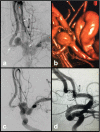The evolution of intracranial aneurysm treatment techniques and future directions
- PMID: 33891216
- PMCID: PMC8827391
- DOI: 10.1007/s10143-021-01543-z
The evolution of intracranial aneurysm treatment techniques and future directions
Abstract
Treatment techniques and management guidelines for intracranial aneurysms (IAs) have been continually developing and this rapid development has altered treatment decision-making for clinicians. IAs are treated in one of two ways: surgical treatments such as microsurgical clipping with or without bypass techniques, and endovascular methods such as coiling, balloon- or stent-assisted coiling, or intravascular flow diversion and intrasaccular flow disruption. In certain cases, a single approach may be inadequate in completely resolving the IA and successful treatment requires a combination of microsurgical and endovascular techniques, such as in complex aneurysms. The treatment option should be considered based on factors such as age; past medical history; comorbidities; patient preference; aneurysm characteristics such as location, morphology, and size; and finally the operator's experience. The purpose of this review is to provide practicing neurosurgeons with a summary of the techniques available, and to aid decision-making by highlighting ideal or less ideal cases for a given technique. Next, we illustrate the evolution of techniques to overcome the shortfalls of preceding techniques. At the outset, we emphasize that this decision-making process is dynamic and will be directed by current best scientific evidence, and future technological advances.
Keywords: Aneurysms; Clipping; Coiling; Endovascular embolization; Flow diversion; Stents; Subarachnoid hemorrhage.
© 2021. The Author(s).
Conflict of interest statement
The authors declare no competing interests.
Figures










References
-
- Aboukais R, Zairi F, Bourgeois P, Boustia F, Leclerc X, Lejeune JP. Pericallosal aneurysm: a difficult challenge for microsurgery and endovascular treatment. Neurochirurgie. 2015;61:244–249. - PubMed
-
- Albuquerque FC, Gonzalez LF, Hu YC, Newman CB, McDougall CG. Transcirculation endovascular treatment of complex cerebral aneurysms: technical considerations and preliminary results. Neurosurgery. 2011;68:820–829. - PubMed
-
- Alreshidi M, Cote DJ, Dasenbrock HH, Acosta M, Can A, Doucette J, Simjian T, Hulou MM, Wheeler LA, Huang K, Zaidi HA, Du R, Aziz-Sultan MA, Mekary RA, Smith TR. Coiling versus microsurgical clipping in the treatment of unruptured middle cerebral artery aneurysms: a meta-analysis. Neurosurgery. 2018;83:879–889. - PubMed
-
- AngioCalc, AngioCalc Cerebral and Peripheral Aneurysm Calculator.
-
- Arthur AS, Molyneux A, Coon AL, Saatci I, Szikora I, Baltacioglu F, Sultan A, Hoit D, Delgado Almandoz JE, Elijovich L, Cekirge S, Byrne JV, Fiorella D, W.-I.S. investigators The safety and effectiveness of the Woven EndoBridge (WEB) system for the treatment of wide-necked bifurcation aneurysms: final 12-month results of the pivotal WEB Intrasaccular Therapy (WEB-IT) Study. J Neurointerv Surg. 2019;11:924–930. - PMC - PubMed
Publication types
MeSH terms
LinkOut - more resources
Full Text Sources
Medical
Miscellaneous

